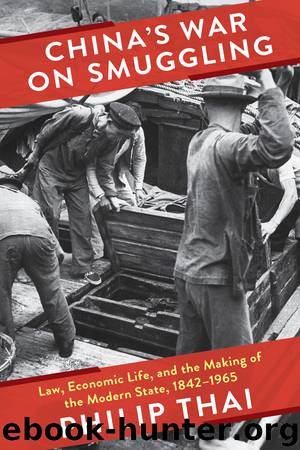China's War on Smuggling by Philip Thai

Author:Philip Thai
Language: eng
Format: epub
Publisher: Columbia University Press
6
STATE REBUILDING AND NEW SMUGGLING GEOGRAPHIES
Restoring and Evading Economic Controls in Civil War China
On May 7, 1948, officers from the Chinese Maritime Customs Service boarded the steamship Shengking (Shengjing), which had just arrived in Shanghai from Hong Kong. A routine inspection uncovered an assortment of ordinary consumer products hidden throughout the ship’s cabins—nylon stockings, woolen socks, and construction nails. Required duties were not paid on any of the items. Nor were they listed on the ship’s manifest or even permitted for import. No one witnessed the goods being stashed away before docking, but suspicion quickly centered on two sailors who purportedly had access to the cabins with the hidden goods. The officers detained the pair and transferred them with a full report of their investigation to the Shanghai Local Court. The suspects faced imprisonment if they were convicted, but the prosecutor released them less than three weeks later on May 25 after they were further interrogated. The prosecutor justified the release due to the absence of direct evidence and the relatively minor value of the smuggled goods involved.1
Around the time of this incident, in early 1948, the outcome of the Chinese Civil War (1946–1950) still hung in the balance. The decisive military campaigns in North and central China were still months away, but international and domestic attention already focused on the escalating conflict between the Nationalists and the Communists. The smuggling on board the Shengking, by contrast, was a routine affair that merited little attention from the public. Almost every facet of the incident was pedestrian, from the goods trafficked to the suspects arrested. So too was the vector of the trafficking. Steamships plying the Hong Kong–Shanghai route had long served as channels for smuggled goods. Yet the incident still encapsulates the many aspects of smuggling during the civil war: a volatile economy and tightening regulations that once again made trafficking ordinary consumer products profitable. This confluence was a product of forces old and new. Smuggling in the years after the Second Sino-Japanese War was similar to smuggling during the Nanjing Decade. On water, goods still arrived at coastal ports by steamships, motorboats, and junks. On land, they made their way into cities and villages by foot and trains. Smuggling’s scale, however, was magnified by conditions inherited from wartime—a shattered economy, civil strife, and weakened authority. The new postwar geopolitical order further complicated state efforts to crack down on smuggling. As legal international trade in theory could only be conducted with the sanction of states, the ambiguous relations Nationalist China enjoyed with the governments of a defeated Japan and an independent Korea created opportunities for merchants unconstrained by diplomatic fictions to (re)connect supply and demand. In the face of these new challenges, the Nationalist government relied on the Chinese Maritime Customs Service to assume its traditional role policing and taxing trade. But like the rest of the Nationalist government, the agency also emerged from the war considerably weakened. With material assets destroyed by years of conflict and staff discipline eroded
Download
This site does not store any files on its server. We only index and link to content provided by other sites. Please contact the content providers to delete copyright contents if any and email us, we'll remove relevant links or contents immediately.
Waking Up in Heaven: A True Story of Brokenness, Heaven, and Life Again by McVea Crystal & Tresniowski Alex(37638)
Still Foolin’ ’Em by Billy Crystal(36247)
Cecilia; Or, Memoirs of an Heiress — Volume 1 by Fanny Burney(32403)
Cecilia; Or, Memoirs of an Heiress — Volume 3 by Fanny Burney(31801)
Cecilia; Or, Memoirs of an Heiress — Volume 2 by Fanny Burney(31773)
Fanny Burney by Claire Harman(26505)
Empire of the Sikhs by Patwant Singh(22944)
We're Going to Need More Wine by Gabrielle Union(18938)
Hans Sturm: A Soldier's Odyssey on the Eastern Front by Gordon Williamson(18451)
Plagued by Fire by Paul Hendrickson(17312)
Out of India by Michael Foss(16772)
All the Missing Girls by Megan Miranda(15466)
Cat's cradle by Kurt Vonnegut(15136)
Pimp by Iceberg Slim(14290)
Molly's Game by Molly Bloom(14042)
Bombshells: Glamour Girls of a Lifetime by Sullivan Steve(13946)
Leonardo da Vinci by Walter Isaacson(13134)
For the Love of Europe by Rick Steves(12539)
4 3 2 1: A Novel by Paul Auster(12253)
